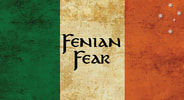Australia's first convicts (757 adults and 13 children) arrived on the First Fleet which sailed into Botany Bay in January 1788, while the last convict ship Hougoumont arrived in the Swan River Penal Colony of Western Australia (Fremantle) in January 1868 with 280 male convicts on board.
Between 1788 and 1868, approx. 159,000 convicts had arrived in Australia. Amongst the transported convicts were murderers, thieves, rapists, paedophiles and petty criminals. Historians conservatively estimate that about one quarter of the males and one third of females transported came directly from Ireland. How many Irish political prisoners or Fenians were amongst transported convicts is difficult to ascertain; however its presumed by most historians that at least ten per cent of those transported from Ireland were 'prisoners of conscious'.
Transportation of Fenians began in earnest during what was referred to as the 'Young Ireland' movement period; mainly during the peak of the Irish Famine (1845) when almost one and half million Irish people died of starvation and disease. Many transported Fenians received a life sentence (some with hard labour) for their crime of treason against the British Crown, and with some ending up in notorious hell-holes in Tasmania (Van Dieman's Land) or on Norfolk Island.
Many of the transported Fenians would become politically energised by their inhumane treatment in British colonial prisons, and some, after escaping or being pardoned, would pursue politics, commerce or journalism as a way and means of liberating their country of birth including their comrades still incarcerated in prisons.
In 1848, 'Young Irelanders' such as Thomas Meagher, William Smith O'Brian, Terence Bellew McManus and John Martin were arrested and charged with treason and sentenced to life in the Penal Colony of Van Dieman's Land. Meagher and McManus however managed to escape, while Smith, O'Brian and Martin were pardoned in 1854. Meagher would later lead the Irish Brigade into battle during the American Civil War. We'll delve more into the life of the remarkable Thomas Meagher later.
West Australian Fenians:
Of the approx. 159,000 convicts transported to Australia between 1877 and 1868, approx. 9,600 were sent to Western Australia.
When the last convict ship (Hougoumont) to arrive in Australia anchored off Fremantle, Western Australia (January 9 1868), amongst the 280 convicts on board were 62 Irish political prisoners (Fenians). And little did they know that when they took their first steps on Australian soil in chains, they would leave a footprint that would span a period of over 150 years.
One such footprint still celebrated today is the escape of 6 Hougoumont Fenian prisoners from Fremantle Prison in 1876. Referred to by historians as The Catalpa Rescue, saw an elaborate Fenian plan that entailed the purchasing of the whaling barque (Catalpa) in New Bedford (America), and sailed to Western Australia disguised as whaling ship to rescue the prisoners.
Over the coming months, with help and contributions of friends, historians, researchers, writers, authors and poets, we'll delve into the lives of the Hougoumont Fenians including the contribution they made to their country of birth, and role they played in helping shape the fabric of Australian society.
Between 1788 and 1868, approx. 159,000 convicts had arrived in Australia. Amongst the transported convicts were murderers, thieves, rapists, paedophiles and petty criminals. Historians conservatively estimate that about one quarter of the males and one third of females transported came directly from Ireland. How many Irish political prisoners or Fenians were amongst transported convicts is difficult to ascertain; however its presumed by most historians that at least ten per cent of those transported from Ireland were 'prisoners of conscious'.
Transportation of Fenians began in earnest during what was referred to as the 'Young Ireland' movement period; mainly during the peak of the Irish Famine (1845) when almost one and half million Irish people died of starvation and disease. Many transported Fenians received a life sentence (some with hard labour) for their crime of treason against the British Crown, and with some ending up in notorious hell-holes in Tasmania (Van Dieman's Land) or on Norfolk Island.
Many of the transported Fenians would become politically energised by their inhumane treatment in British colonial prisons, and some, after escaping or being pardoned, would pursue politics, commerce or journalism as a way and means of liberating their country of birth including their comrades still incarcerated in prisons.
In 1848, 'Young Irelanders' such as Thomas Meagher, William Smith O'Brian, Terence Bellew McManus and John Martin were arrested and charged with treason and sentenced to life in the Penal Colony of Van Dieman's Land. Meagher and McManus however managed to escape, while Smith, O'Brian and Martin were pardoned in 1854. Meagher would later lead the Irish Brigade into battle during the American Civil War. We'll delve more into the life of the remarkable Thomas Meagher later.
West Australian Fenians:
Of the approx. 159,000 convicts transported to Australia between 1877 and 1868, approx. 9,600 were sent to Western Australia.
When the last convict ship (Hougoumont) to arrive in Australia anchored off Fremantle, Western Australia (January 9 1868), amongst the 280 convicts on board were 62 Irish political prisoners (Fenians). And little did they know that when they took their first steps on Australian soil in chains, they would leave a footprint that would span a period of over 150 years.
One such footprint still celebrated today is the escape of 6 Hougoumont Fenian prisoners from Fremantle Prison in 1876. Referred to by historians as The Catalpa Rescue, saw an elaborate Fenian plan that entailed the purchasing of the whaling barque (Catalpa) in New Bedford (America), and sailed to Western Australia disguised as whaling ship to rescue the prisoners.
Over the coming months, with help and contributions of friends, historians, researchers, writers, authors and poets, we'll delve into the lives of the Hougoumont Fenians including the contribution they made to their country of birth, and role they played in helping shape the fabric of Australian society.

